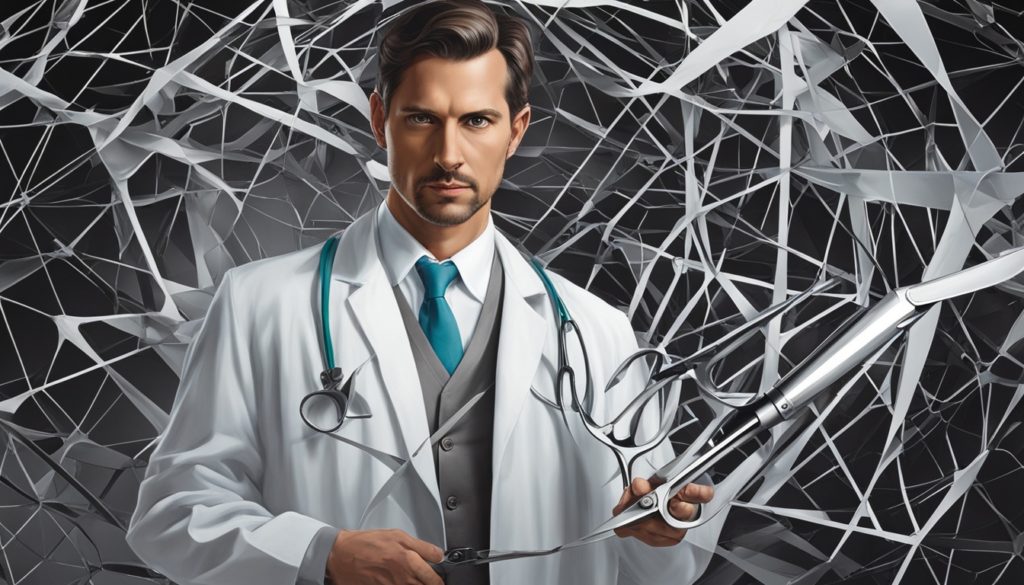Did you know prostate cancer is the second most common cancer in men worldwide? It often goes unnoticed until it’s too late, thanks to many myths. After King Charles III spoke out, people are now focusing on the truth about prostate cancer. This article will clear up the myths and stress the need for early screening to improve treatment chances.
Key Takeaways
- Prostate cancer is the second most common cancer among men globally.
- Misconceptions about prostate cancer can delay early detection and treatment.
- Understanding the facts can lead to better health outcomes and reduced stigma.
- Early screenings play a vital role in the effective treatment of prostate cancer.
- Recent discussions have highlighted the urgency of addressing these myths.
Understanding Prostate Cancer
Prostate cancer is a big health issue for many men, with 299,010 new cases expected in the U.S. in 2024. This shows why it’s important to clear up Prostate Cancer Misconceptions and debunk Prostate Health Myths.

What is Prostate Cancer?
Prostate cancer starts in the prostate, a small gland in men that makes seminal fluid. The cancer can be slow-growing or fast-moving. Knowing about prostate cancer helps in finding the right treatment.
Prevalence and Risk Factors
Most men get prostate cancer around age 67. Being older, African American, or having a family history increases the risk. About one in eight men will get prostate cancer at some time. Younger men with risk factors should also watch out.
Here’s a quick look at risk factors for prostate cancer:
| Risk Factor | Impact on Risk |
|---|---|
| Age | Increases dramatically after age 50 |
| Race/Ethnicity | Higher incidence in African American men |
| Family History | Higher risk if a close family member has had prostate cancer |
The Importance of Early Detection
Finding prostate cancer early can make treatment more effective. Men should get regular PSA tests starting at 50, or earlier if there are risk factors. Fighting Prostate Cancer Misconceptions and catching it early can save lives.
Common Myths About Prostate Cancer
Many people have wrong ideas about prostate cancer. It’s important to clear up these myths for better understanding and early detection.
Myth 1: Prostate Cancer Always Causes Symptoms
One big Prostate Cancer Myth is that it always shows symptoms like trouble with urination. But, most prostate cancers don’t have symptoms. They are often found through PSA tests, not symptoms.
This shows why regular tests are key, even if you don’t have symptoms.

Myth 2: Only Older Men Get Prostate Cancer
Many think prostate cancer only hits older men. But, it can happen to younger men too. Catching it early is crucial for all men, no matter their age.
This helps fight Common Myths about Prostate Cancer and lowers the risk of serious prostate cancer.
| Myth | Fact |
|---|---|
| Prostate cancer always causes symptoms | Most cases are asymptomatic and detected through PSA tests |
| Only older men get prostate cancer | Affects men of various ages, though prevalence is higher among older men |
Debunking Prostate Cancer Myths
Many people doubt the value of PSA screenings for prostate cancer. Dr. Timothy Showalter from ArteraAI says these screenings are key to finding cancer early. Finding cancer early means it can be treated on time, which could save lives.
Some think all prostate cancers need quick action. But, not every cancer is a threat. Some cancers are low-grade and can be watched closely without harsh treatments. This lets patients keep their quality of life. On the other hand, some cancers are aggressive and need strong treatment plans.
Many believe prostate cancer treatment harms sexual function. But, studies show most men can still have sex after treatment. This myth causes a lot of worry for those facing the diagnosis.
Let’s explore some of these myths and what’s really true:
| Myth | Reality |
|---|---|
| PSA screenings are ineffective | PSA screenings are vital for early-stage detection |
| All prostate cancers need immediate treatment | Low-grade cancers can be safely monitored |
| Prostate cancer treatment ends sexual function | Sexual function often continues post-treatment for most men |
It’s crucial to clear up these wrong ideas about prostate cancer. This helps people understand better and makes them more informed about their choices.
The Role of PSA Screening
PSA screening is key in finding prostate cancer early. It helps people understand how the test works and its guidelines. This way, they can make better health choices.
How PSA Screening Works
PSA screening checks the prostate-specific antigen in blood. High levels may mean prostate cancer or other issues. Men over 50 should get tested, but those at higher risk might start earlier.
Controversies Surrounding PSA Screening
PSA screening has its critics. Some say it leads to too many false positives and unnecessary treatments. But others believe it finds cancer early, saving lives.
Guidelines for PSA Testing
Doctors have different advice on PSA screening. The American Cancer Society says men should talk to their doctors about it at 50. African American men or those with a family history should talk about it at 45.
Prostate Cancer Symptoms and Early Signs
Knowing the signs of prostate cancer is key to catching it early. Some symptoms are clear, but others are not. This is why regular check-ups are important.
Common Symptoms to Watch For
Prostate cancer can have symptoms that seem like other health issues. Here are some signs to watch for:
- Frequent urination, especially at night
- Difficulty starting or stopping urine flow
- Weak or interrupted urine stream
- Painful or burning sensation during urination
- Blood in urine or semen
- Persistent pain in the back, hips, or pelvis
Silent Symptoms – The Importance of Screening
Many early signs of prostate cancer are not noticeable. This highlights the need for regular tests like PSA tests. These tests help find problems early.
Even if you don’t have symptoms, regular tests are crucial. They help catch prostate cancer early. Being aware of these signs can greatly improve treatment outcomes.
Effective Treatment Options for Prostate Cancer
There are many ways to fight prostate cancer. The right treatment depends on how serious the cancer is and the patient’s health. This section looks at the best treatments to help patients get the best care.
Surgical Treatments
Surgery is a key part of treating prostate cancer. With modern techniques like robotic-assisted prostatectomy, surgery has gotten better. It helps by reducing complications and making recovery faster. People with cancer that hasn’t spread get surgery to remove the tumor and save as much function as they can.
Radiation Therapy
Radiation therapy is a big part of fighting prostate cancer. It uses high-energy rays to kill cancer cells. It works well for men with cancer that hasn’t spread much. There are two main types: external beam radiation and brachytherapy. External beam radiation comes from outside the body. Brachytherapy puts radioactive seeds right into the prostate.
Hormone and Chemotherapy
For advanced prostate cancer, hormone and chemotherapy are important treatments. Hormone therapy lowers male hormones to slow cancer growth. It’s often used with other treatments like radiation. Chemotherapy uses strong drugs to kill cancer cells that grow fast. It’s for cancer that has spread or if other treatments didn’t work.
Prostate Cancer Treatment Options are always getting better. They offer hope and a better quality of life to those affected. The right treatment is chosen based on the patient’s needs and the cancer’s details, aiming for the best results.
| Treatment Option | Description | Best For |
|---|---|---|
| Surgical Treatments | Includes prostatectomy, often robotic-assisted, aimed at removing the tumor | Localized prostate cancer |
| Radiation Therapy | Uses high-energy rays to destroy cancer cells, including external beam and brachytherapy | Localized and slightly advanced prostate cancer |
| Hormone Therapy | Reduces male hormone levels to slow cancer growth | Advanced or recurrent prostate cancer |
| Chemotherapy | Utilizes powerful drugs to kill rapidly dividing cancer cells | Advanced prostate cancer or when other treatments fail |
Prostate Cancer and Sexual Health
Prostate cancer treatment can change a man’s life in many ways, especially his sexual health. But, it’s key to remember that treatment doesn’t mean the end of sexual function. Knowing how treatment affects sexual health and how to manage it is vital for a good quality of life.
Impact of Treatment on Sexual Function
Treatments like surgery, radiation, and hormone therapy can change sexual function. Men may face erectile dysfunction (ED), a drop in libido, and trouble reaching orgasm. These issues happen because the nerves and blood vessels needed for arousal and erections can be harmed during treatment.
Managing Sexual Health Post-Treatment
Handling sexual health after treatment requires a detailed plan. Doctors often suggest medications like sildenafil (Viagra) and tadalafil (Cialis) for ED. For those not helped by pills, vacuum devices and penile implants are other options.
Psychological support and counseling are key for managing sexual health after prostate cancer. Men and their partners can benefit from sexual therapy to deal with the emotional and psychological sides of sexual issues post-treatment. Talking openly with each other helps manage expectations and find ways to keep intimacy strong.
Getting back to normal sexual function is important after prostate cancer treatment. Men should talk openly with their doctors about their sexual health. Exploring different strategies can help them keep a fulfilling sexual life after treatment.
Living a Healthy Lifestyle to Lower Risk
Living a Healthy Lifestyle Prostate Cancer can lower the risk of health issues. A key part of this is eating well, staying active, and getting regular health checks. This is especially true if you have a family history of prostate cancer.
Diet and Prostate Health
Eating foods like fruits, veggies, whole grains, and lean meats is good for your prostate. Foods such as tomatoes, berries, and fatty fish help keep your prostate healthy. On the other hand, eating too much red or processed meat can increase your risk of prostate cancer. Eating wisely is a big part of a Healthy Lifestyle Prostate Cancer.
The Role of Exercise
Exercise is key in lowering prostate cancer risk. Doing different types of workouts, like running, lifting weights, and stretching, boosts your overall health and prostate health. Being active not only lowers cancer risk but also helps keep a healthy weight, which is vital for prostate health. Diet and Exercise for Prostate Health show how important moving is in preventing cancer.
Regular Health Check-Ups
Regular health check-ups are vital for catching prostate cancer early. Tests like the PSA test can spot problems before they get worse. If you have a family history of prostate cancer, you should be extra careful. Make sure you follow screening guidelines and talk to your doctor often. For more info on cancer myths, check out research findings. These steps are crucial for a Healthy Lifestyle Prostate Cancer.
Importance of Awareness and Education
Raising Prostate Cancer Awareness and improving Prostate Cancer Education are key to fighting the disease’s stigma. By talking openly and offering community help, people can learn more and take charge of their health.
Breaking the Stigma Around Prostate Cancer
We need ongoing education to beat the prostate cancer stigma. Awareness campaigns push men to get regular check-ups, which is crucial for catching the disease early. In places like South Africa, these efforts are showing success by making men talk about prostate cancer tests and encouraging them to look after their health.
Community Support and Resources
Community support is vital for prostate cancer education. Local groups, health care providers, and organizations offer great help and resources. They teach men why catching cancer early is important and help them during treatment. Here’s a look at the support options:
| Support System | Details |
|---|---|
| Local Support Groups | Give a safe place for sharing stories and getting emotional support. |
| Healthcare Providers | Offer expert advice, tests, and treatment choices. |
| Non-Profit Organizations | Run awareness campaigns and give out educational materials and funds. |
Conclusion
It’s key to fight prostate cancer myths to win the battle against the disease. Wrong beliefs can cause too much fear or not enough action. We need to spread the truth to help people make smart health choices.
Knowing how important prostate health is should guide every man’s health care. Tests like the PSA test and catching cancer early can really help. By focusing on these steps, we aim to cut down prostate cancer deaths.
A healthy life with good food, exercise, and regular doctor visits can also lower prostate cancer risk. Support from others and health resources is crucial for staying on top of prostate health. As we clear up false ideas and push for more awareness, let’s remember that our mental and physical health are linked. Taking control of our health means being informed and acting fast.
FAQ
What is Prostate Cancer?
Prostate cancer is a type of cancer that affects the prostate gland in men. It’s a common cancer in men.
What are the risk factors for prostate cancer?
Risk factors include age, race, family history, and genetics. It’s most common in men over 50.
Why is early detection of prostate cancer important?
Early detection is key for successful treatment. PSA screenings and check-ups help catch it early.
Does prostate cancer always cause symptoms?
No, it doesn’t always cause symptoms. Many cases are found through PSA screenings, not symptoms.
Is prostate cancer only a concern for older men?
It’s more common in older men but can happen in younger men too. Risk factors, not just age, guide PSA screenings.
How does PSA screening work?
PSA screening measures prostate-specific antigen in blood. High levels can mean cancer or other issues, leading to more tests.
What are the controversies surrounding PSA screening?
There are debates about overdiagnosis and overtreatment. But early detection’s benefits often outweigh these concerns.
What are the guidelines for PSA testing?
Guidelines suggest starting screenings at 50 for average-risk men. Those with higher risk factors may start earlier.
What are some common symptoms of prostate cancer?
Symptoms include trouble urinating, weak urine stream, blood in urine, and pelvic discomfort. But many men don’t show these signs.
What are the treatment options for prostate cancer?
Options include surgery, radiation, hormone therapy, and chemotherapy. The choice depends on the cancer stage and health.
How can treatment for prostate cancer affect sexual health?
Treatments can cause erectile dysfunction and other issues. But there are therapies to help manage these effects.
Can a healthy lifestyle lower the risk of developing prostate cancer?
Yes, eating well, exercising, and regular check-ups can lower the risk. Early detection is key.
Why is it important to raise awareness and educate about prostate cancer?
Awareness helps fight myths, promotes early screenings, and supports those affected. It leads to better health outcomes through early detection and treatment.


